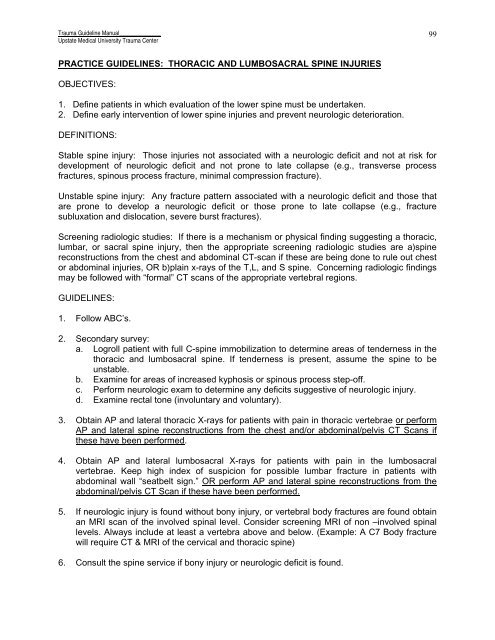Trauma Guideline Manual - SUNY Upstate Medical University
Trauma Guideline Manual - SUNY Upstate Medical University
Trauma Guideline Manual - SUNY Upstate Medical University
Create successful ePaper yourself
Turn your PDF publications into a flip-book with our unique Google optimized e-Paper software.
<strong>Trauma</strong> <strong>Guideline</strong> <strong>Manual</strong>______________<strong>Upstate</strong> <strong>Medical</strong> <strong>University</strong> <strong>Trauma</strong> Center99PRACTICE GUIDELINES: THORACIC AND LUMBOSACRAL SPINE INJURIESOBJECTIVES:1. Define patients in which evaluation of the lower spine must be undertaken.2. Define early intervention of lower spine injuries and prevent neurologic deterioration.DEFINITIONS:Stable spine injury: Those injuries not associated with a neurologic deficit and not at risk fordevelopment of neurologic deficit and not prone to late collapse (e.g., transverse processfractures, spinous process fracture, minimal compression fracture).Unstable spine injury: Any fracture pattern associated with a neurologic deficit and those thatare prone to develop a neurologic deficit or those prone to late collapse (e.g., fracturesubluxation and dislocation, severe burst fractures).Screening radiologic studies: If there is a mechanism or physical finding suggesting a thoracic,lumbar, or sacral spine injury, then the appropriate screening radiologic studies are a)spinereconstructions from the chest and abdominal CT-scan if these are being done to rule out chestor abdominal injuries, OR b)plain x-rays of the T,L, and S spine. Concerning radiologic findingsmay be followed with “formal” CT scans of the appropriate vertebral regions.GUIDELINES:1. Follow ABC’s.2. Secondary survey:a. Logroll patient with full C-spine immobilization to determine areas of tenderness in thethoracic and lumbosacral spine. If tenderness is present, assume the spine to beunstable.b. Examine for areas of increased kyphosis or spinous process step-off.c. Perform neurologic exam to determine any deficits suggestive of neurologic injury.d. Examine rectal tone (involuntary and voluntary).3. Obtain AP and lateral thoracic X-rays for patients with pain in thoracic vertebrae or performAP and lateral spine reconstructions from the chest and/or abdominal/pelvis CT Scans ifthese have been performed.4. Obtain AP and lateral lumbosacral X-rays for patients with pain in the lumbosacralvertebrae. Keep high index of suspicion for possible lumbar fracture in patients withabdominal wall “seatbelt sign.” OR perform AP and lateral spine reconstructions from theabdominal/pelvis CT Scan if these have been performed.5. If neurologic injury is found without bony injury, or vertebral body fractures are found obtainan MRI scan of the involved spinal level. Consider screening MRI of non –involved spinallevels. Always include at least a vertebra above and below. (Example: A C7 Body fracturewill require CT & MRI of the cervical and thoracic spine)6. Consult the spine service if bony injury or neurologic deficit is found.
















